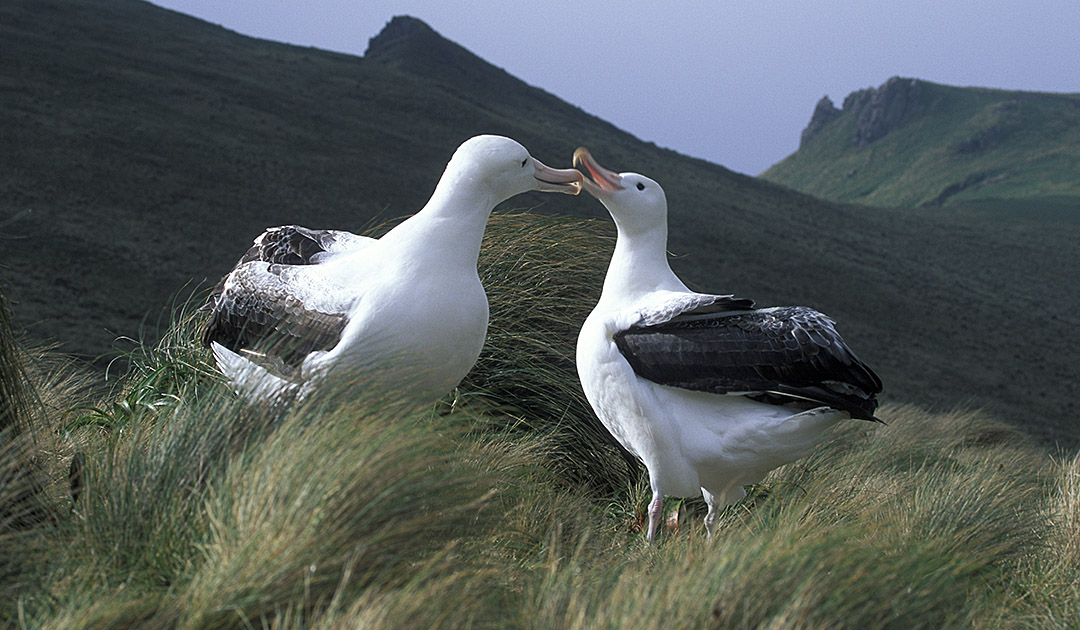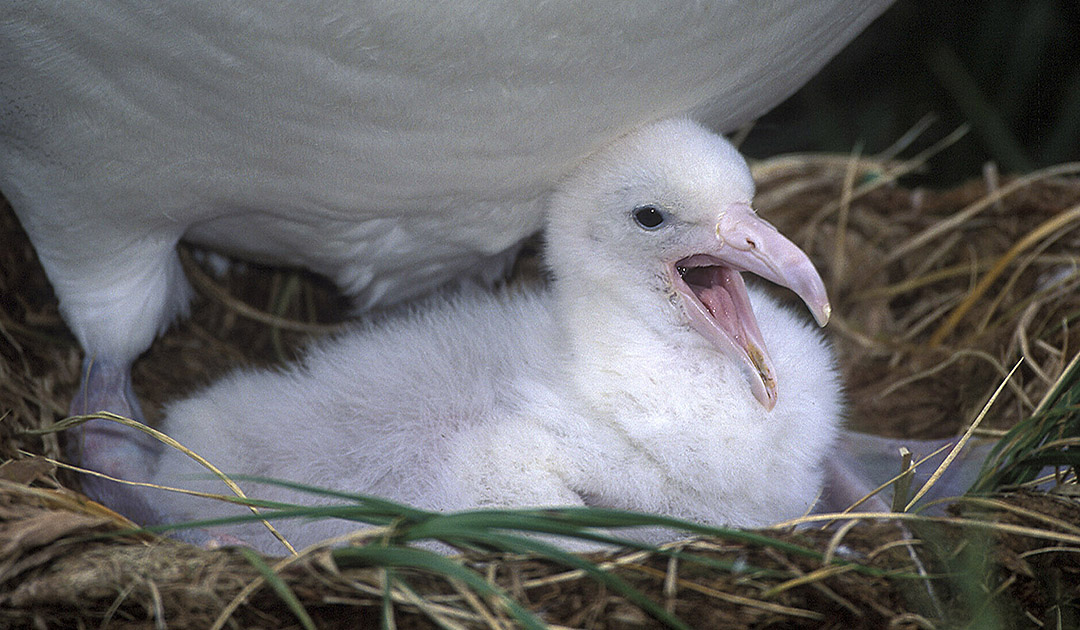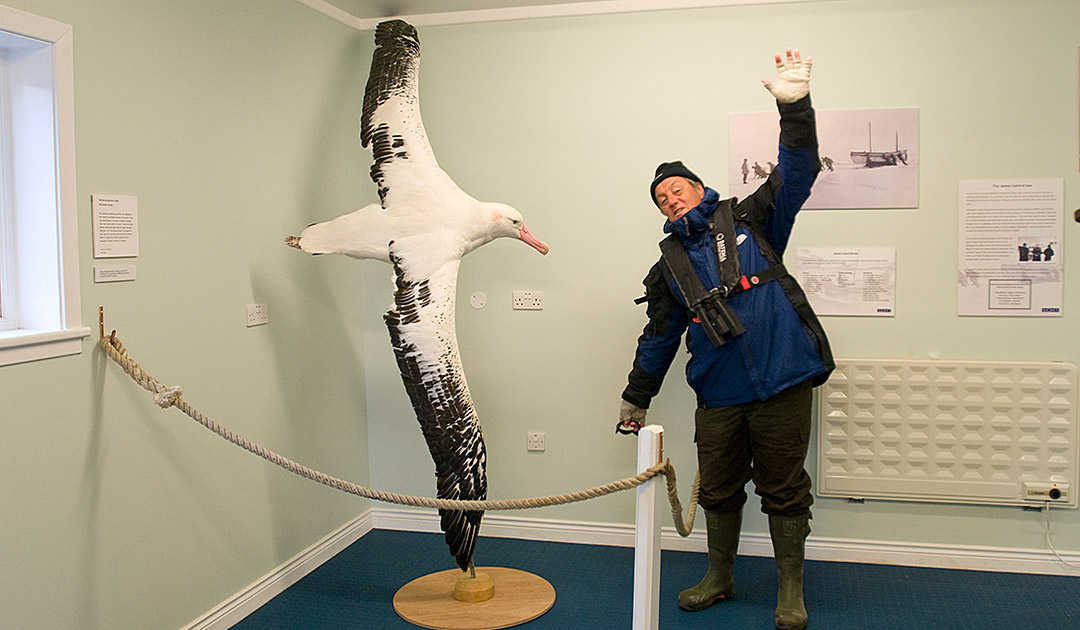
Countless days had passed, and still the white albatross followed the fast three-mast clipper with course Cape Horn. When the sails began to fill with strong winds and the first salty spray reached the wooden planks of the front deck, the ship began to roll. In the narrow galley, the pots slipped off the stove to the smut. Only the loud howling and roaring of the wind prevented the curses of the ship’s cook from mixing with those of the sailors on deck. They covered the white albatross far behind the keel with indecent curses, because he, the big, silent glider, was to blame for the storm near Cape Horn – who else!

Since time immemorial, legends and myths have been swirling around the wandering albatross, the largest flying bird on earth. When the explorers of the stormy seas came home, they told with a certain shyness of large birds far, far from land. And with respect and reverence, there was always a disturbing sense of fear in those stories. Albatrosses often appeared in the Southern Ocean during large storms. Therefore, the crews of the old sailing ships spoke of the “Albatross-latitudes” as soon as their clippers had reached the zones of the roaring forties and the furious fifties (about at Cape Horn). The ancient mariners blamed the albatross for the bad weather, and some of these birds even lost their lives because mariners shot them out of superstitions in the hope that the storm would settle down.
Other sailors, on the other hand, suspected that albatrosses carry the souls of drowned colleagues with them, and they would never have hurt an albatross in their life. The nautical profession of the provisions master also knew how to tell stories about the albatross. Underpaid and constantly concerned for their accounting records (they could have been destroyed in naval battles, eaten by rats or soaked by the storm…), the provion master was also met with a constant deep distrust of the sailors. All superstitious people were sure that the albatross would embody the soul of a deceased provision master who constantly follows his old ship and hopes to continue to plague the crew with even more fraud and stinginess.

Majestic perpetual swifts
The wandering albatross – what a bird! Its dynamic sailing just above the waves of the Southern Ocean remains unforgettable in its elegance and grandeur to all those who had the chance to observe a wandering albatross. Almost meditatively, he majestically seems to play with the wind and the waves without the slightest sign of a exertion like in a perpetual slow motion. A master of flying!
As an pronounced seabird, the wandering albatross together with diving and storm petrels belongs to the tubenoses. Not only is it the largest of all among the 22 or so albatross species in the world – with its wingspan of up to 3.5 meters, there is no larger flying bird anywhere else in the world. (Because the species status of some populations of isolated subantarctic islands is disputed among experts, the number of species varies depending on the source.)

Heavy bird
As impressive as the wing mass is also the body-length: from the beak tip to the last tail-feather, such a wandering albatross body measures up to 1.35 meters. And if there was a scale somewhere in the Southern Ocean, one would find a weight between about 9 and almost 12 kilograms. Males are up to 20 percent larger than females, which hardly facilitates the exact determination of a migratory albatross as a bird watcher. Basically, it is not so easy to distinguish a wandering albatross from some other big albatrosses. Especially the Southern Royal Albatross looks very similar to it. The younger a wandering albatross, the more brownish the overall impression of the plumage (unfortunately also applies to the others…). But also the mostly white-looking plumage of full-grown wandering albatrosses is very different dark colored in certain places, depending on the sex, age and breeding area.
Ornithologists estimate that nowadays, there are about 6000 breeding pairs of wandering albatrosses worldwide, i.e. nota bene around Antarctica, or about 20,100 adult individuals – decreasing. Although wandering albatrosses can be found on all the oceans around Antarctica, when it comes to the question of breeding, they have chosen a few small, windy islands on the northern edge of the Southern Ocean. A quarter of all breeding wandering albatrosses live on South Georgia, with more than half sharing the two tiny, storm-tossed islands of Prince Edward Island and Marion. And just over a tenth can be found on the French archipelagos of Crozet and Kerguelen.

The Myth of Fidelity
Each wandering albatross returns with a probability of 70 to 90 percent every second November to breed in the vicinity of the last nest in “his” colony and back to “his” island, where he once saw the shining light of the southern world. At the age of 5 years at the earliest, it can start breeding, but an average wandering albatross does not give up his single life until 9 or 10 years of age. Choosing a future mating partner is a crucial question – which is why wandering albatrosses are among the most picky of all seabirds. After all, the albatross chooses its spouse for life. However, the famous fidelity to the partners among the wandering albatrosses has suffered badly due to a scientific study. On Marion Island in the southern Indian Ocean, it has been observed that the lifelong fidelity attributed to the albatrosses is a matter of opinion: extramarital paternity is common in almost one-fifth of all couples on this windy island. And females of couples who remain without offspring agree with affairs of their partners.
With so much leniency, it is not surprising that mating birds greet each other intensively when they find their way home in November after many winter months as single fliers somewhere in the Southern Ocean. This welcome ritual and the subsequent courtship behavior is one of the most beautiful behaviors that can be experienced in animals. Dignified, even solemn, the birds walk around each other and almost outdo each other in their repertoires: processional dances are performed, beak fencing, bowing, beak drums, sky-pointing, or – even more pronounced and extremely photogenic: the uplift of the head.

Nesting only every two years
A single egg weighing around 500 grams is laid in December/January. Each partner then breeds for 8 to 15 days until relief; up to 40 days have been observed. During this time, the brooding bird may lose up to a third of its body weight. It takes almost 80 days for the young albatross to hatch around March. From now on, the young bird perched on his nest for about 280 days – an enormously long time in the bird world. After the joint care by both parents, the young bird is fully fledged in November. After that, the adult wandering albatrosses give up on their single chick.

Always follow the (tube)nose
Albatrosses travel huge distances in flight without ever actively flapping their wings. Gaining energy from the wind is the motto, and the dynamic sailing flight offers this huge bird the best results: rise against the wind, descend with the wind to just above the water line. The wind provides 80 to 90 percent of the energy for gliding, the rest comes from the waves.
If a wandering albatross changes direction during dynamic sailing, it sometimes tilts its wings more than 90 degrees – but its head, the control center, always remains perfectly aligned in the same position. The gliding, taking advantage of the wind and the waves, is so energy-saving that the heartbeat of an albatross gliding in the wind corresponds to that of a dormant bird – no effort, no hustle and bustle.
However, wandering albatrosses are doomed to sit around on the ocean surface in low winds or in calm winds…
Transmitters installed by scientists also offer an insight into the flying behaviour of albatrosses far from the land. For example, the measured maximum speeds were over 85 kilometers per hour. Another wandering albatross under scientific observation covered 1014 kilometers in twenty hours, with an average speed of 72 kilometers per hour.
The seemingly aimless flying around the vastness of the Southern Ocean serves, of course, the search for food. On this subject, a zoological study led by Gabrielle Nevitt, a behavioral researcher at the University of California, has uncovered exciting things: Wandering albatrosses smell their food from up to 20 kilometers away, and about half of all foraging flights follow the nose! For the first time, this researcher and her team have succeeded in tracking wild wandering albatrosses using high-precision GPS sensors and tiny gastric thermometers (which indicate when the bird is feeding) on the long-range foraging flights. Combined with wind data from the meteorologists, Nevitt was able to find out the flight behavior of the wandering albatrosses, their flight route as well as the location and time of a prey catch.
Nevitt recognized several different flight behaviors of wandering albatrosses in search of food. There were those who flew “straight” – those albatrosses did not change their general flight direction, and they did not care about the wind direction, because they steered to a prey on the water, which they clearly had in mind. These straight fliers obviously reacted to visual signals; they saw their food and headed straight for it. Then there were the “turners”: these albatrosses suddenly changed direction to fly directly against the wind – a sign that they had sensed the smell of prey. It has been known for some time that wandering albatrosses have large, well-trained olfactory bulbs, which are among the largest in the bird world. And now the proof has been provided that these olfactory organs are actually being used!
Although the table for the albatrosses in the Southern Ocean is rich and the sea is large, wandering albatrosses of the same colony choose different areas for food depending on their age and sex. Such a distribution of food resources leads to the fact that only old males of the wandering albatrosses of the Crozet Islands, southeast of South Africa, forage south of the polar front. But climate change is confusing this old order – see box.
The polar convergence winds through the oceans around Antarctica at a position of about 50° south latitude; it is the dividing line between the very cold polar surface waters in the south and the warmer water masses north of it.
The females, on the other hand, as well as younger birds and such middle-aged birds never cross the polar front, they remain north of it – but also this group of “northern birds” forages spatially separated: young males start from Crozet to the east, young females on the other hand to the (north)west.
The colonies on South Georgia also divide their flight area: Female animals stop on the Patagonian shelf off the coasts of Argentina and fly up to south Brazil at 28° south latitude (where longline fishing is active), but males are mostly near the coast near their home island of South Georgia, where they can come into conflict with industrial fishing vessels, which are on the search for Patagonian toothfish.

Deadly barbs
When wandering albatrosses meet fishing vessels, they often follow the vessels for days and fall for the fish waste and the scrap, which is directly on board and thrown into the sea when the catch is processed. A welcoming food source for seabirds – apart of the thousands of hooks on long lines spiked with delicious baits! In longline fishing, the fishing vessel pulls a line, often 100 kilometres long, behind it through the sea. More than 2500 side lines with hooks, which are equipped with baits, are attached to the main line. Since buoyancy bodies keep such lines close to the surface of the water, albatrosses get caught in the hook because they dive for the baits.
Many species of sea birds, but also sea turtles, sharks and rays are significantly threatened by the fact that they die in their tens of thousands as an undesirable bycatch of longline fishing. For the first time, a study by BirdLife International counted all seabirds that fall victim to longline fishing worldwide. Despite the many inaccuracies hidden behind the reported figures from the fishing industry, alarming estimates have been made: between 160 000 and 320 000 seabirds are therefore falling victim to longline fishing – every year! And this only reflects the existing by-catch messages; the unreported number of other bird victims is considered to be high. The most frequently represented are albatrosses and petrels, other victims include gulls, terns, boobies and cormorants. If longline fishing is already a major threat to relatively common species such as black-browed and black-footed albatrosses, it becomes a real question of existence for endangered species such as the Amsterdam or Tristan albatrosses. It is also clear now that the decline in the wandering albatross on South Georgia, which has been observed for decades, is very much caused by the Uruguyan fishing fleet. Uruguay’s fishing fleet lays out its longlines for tuna off the coast between the estuary of the Rio de la Plata and southern Brazil, where most South Georgian wandering albatrosses are looking for food. Not surprisingly (but sadly), Uruguay has the highest proportion of by-catch albatrosses; it accounts for 84 percent.
It would be nice to be able to report here that the workers on the fishing vessels would spare the albatross out of superstition – because technical aids for reducing by-catch have been around for a long time. But modern sailors seem to have forgotten that the albatross transports the souls of drowned people and would only deserve our unrestricted protection for that reason alone.

More wind, more weight
Climate change is causing more wind in Antarctica and over the Southern Ocean. The wandering albatross benefits extensively from this, as recent studies show.
In recent decades, wind patterns over the Southern Ocean have changed: the westerly winds are blowing stronger, and they are blowing further south than before. Both effects benefit the wandering albatross because it can now fly faster and therefore has to spend less time for foraging.
This new insight into the life of the largest flying bird comes from the study of an international team of French and German scientists. They compared countless data on the duration of foraging flights, breeding success over the past four decades and the body mass of migratory albatrosses over the past 20 years with the latest studies on birds in the Crozet Islands. There, thanks to mini satellite transmitters, individual wandering albatrosses were tracked on foraging trips up to 3500 kilometres away from the breeding site.
It turned out that females were travelling much southerly and in much windier corners of the Southern Ocean than before. Until now, female wandering albatrosses had flown from the Crozets mostly towards subtropical waters in the north, where they fell victim to longline fishing. Thanks to the new “hunting grounds” in the south, which climate change brings to them, they find their food in less time and do not come into conflict with the baited hooks of the fishing fleets.
More success in breeding
Since the females now have to spend less time at sea – thanks to faster flying in the stronger wind – they can devote themselves longer to incubated the egg. In fact, the researchers noted that breeding success among Crozet’s wandering albatrosses has increased, and that the birds there have gained 1 kilogram in weight today compared to long-term averages.
The west wind belt in the southern hemisphere is not only central for (wandering) albatrosses, it also plays an important role for the global climate. The strength and position of these winds have been subject to constant fluctuations at least since the height of the last ice age, according to a study by paleoclimatologists on the prehistoric climate.
The Southern Ocean around Antarctica, where the westerly winds can flow wide and undisturbed by continental masses, has a dominant influence on the world’s climate due to its ocean currents. In addition to large amounts of heat, the Southern Ocean alone absorbs about 40 percent of the carbon dioxide (CO2) stored in the oceans worldwide.
While important ocean currents, such as the huge Antarctic Circumpolar Current, shift southward within the Southern Ocean, thus changing the horizontal and vertical circulation of water masses, the Southern Ocean already absorbs about one third less of CO2 than in the previous two decades. In addition, the water there is warming, losing its salinity and becoming more and more acidic.
Change continues
The wandering albatross now seems to be the beneficiary of these current changes. However, the good news that the global warming of the climate is also good for an animal species will only apply for a limited period of time. This positive impact of climate change on wandering albatrosses will come to an end if the pattern of the westerly winds in the Southern Ocean continues to change, as climate calculations predict.
The location and intensity of the wind patterns above the Southern Ocean are strongly related to the ozone hole over Antarctica and to the man-made increase in greenhouse gases – both are constantly changing sizes.
For the largest flying bird on earth, we could feel happy for a short time about the ongoing oceanic and climatological changes – but as the largest living polluter of this earth, we should pull ourselves by the ears.
By Peter Balwin (text) and Heiner Kubny (pictures)






